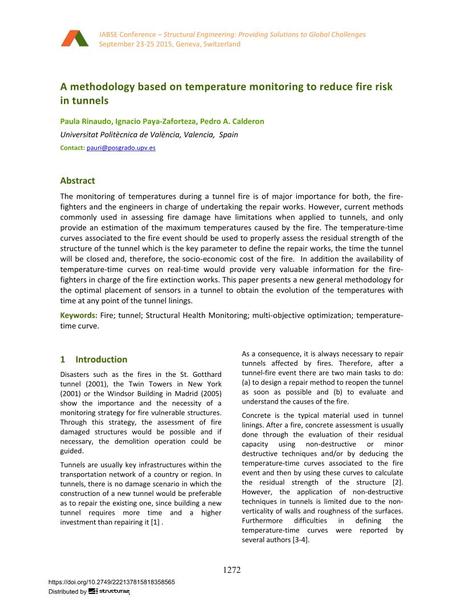A methodology based on temperature monitoring to reduce fire risk in tunnels

|
|
|||||||||||
Bibliografische Angaben
| Autor(en): |
Paula Rinaudo
(Abstract)
Ignacio Payá Zaforteza Pedro Calderón García (Abstract) |
||||
|---|---|---|---|---|---|
| Medium: | Tagungsbeitrag | ||||
| Sprache(n): | Englisch | ||||
| Tagung: | IABSE Conference: Structural Engineering: Providing Solutions to Global Challenges, Geneva, Switzerland, September 2015 | ||||
| Veröffentlicht in: | IABSE Conference Geneva 2015 | ||||
|
|||||
| Seite(n): | 1272-1278 | ||||
| Anzahl der Seiten (im PDF): | 7 | ||||
| Jahr: | 2015 | ||||
| DOI: | 10.2749/222137815818358565 | ||||
| Abstrakt: |
The monitoring of temperatures during a tunnel fire is of major importance for both, the fire- fighters and the engineers in charge of undertaking the repair works. However, current methods commonly used in assessing fire damage have limitations when applied to tunnels, and only provide an estimation of the maximum temperatures caused by the fire. The temperature-time curves associated to the fire event should be used to properly assess the residual strength of the structure of the tunnel which is the key parameter to define the repair works, the time the tunnel will be closed and, therefore, the socio-economic cost of the fire. In addition the availability of temperature-time curves on real-time would provide very valuable information for the fire- fighters in charge of the fire extinction works. This paper presents a new general methodology for the optimal placement of sensors in a tunnel to obtain the evolution of the temperatures with time at any point of the tunnel linings. |
||||
| Stichwörter: |
Brand Tunnel
|
||||

